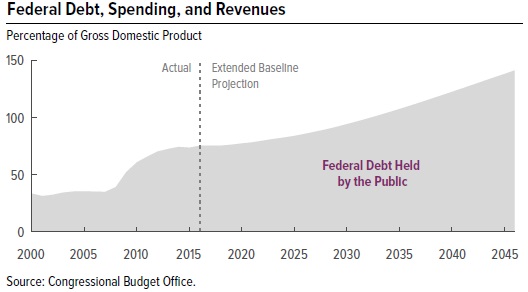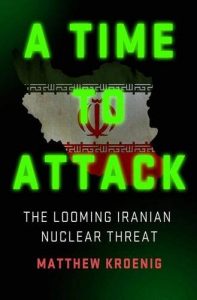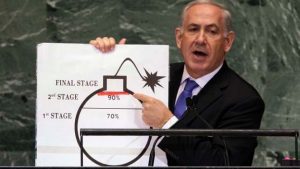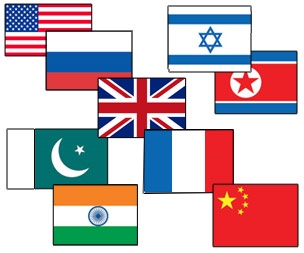by
by Karsten Riise
The US Congressional Budget Office (CBO) has newly released a projection of Federal debt 2016-2046.

The CBO analysis shows that Federal debt is on path to increase from 75% of GDP to 146% of GDP in 2046. These figures exclude state & local government debt of approimately 16% of GDP (source: Fed.Reserve Z1,D1 and BEA.gov), meaning that the total public debt in the USA is on track to increase from 90%+ to 160%+ of GDP.
A public debt of 100%-200% of GDP is possible in Japan and Italy, where nearly all public debt is owned nationally—in Japan, by (often state-promoted) enormous private entities. However, for the USA, such high public debt figures are bound to lead to a fundamental crisis of non-confidence in the US dollar.
Falling dollar rates and rising interest rates will incur still higher deficits to pay the interests on the public debt.
A vicious circle threatens the US economy.
When and how it may start, we don’t know.
The biggest driver of the US Federal debt is the aging of the US population. Today 15% of Americans are aged 65+. This percentage will increase by two thirds, so that by 2060 about 24% of the US population will be 65+. Until now, the USA has benefited from a young population. The strain on medicare and social spending of an aging population, even with the still limited entitlements in the USA, will be enormous.
The CBO has calculated, that just to keep the Federal debt at its present level, the balance between tax revenues and federal expenditures must be improved by 1.7% of GDP—every year the next 30 years. In other words, tax revenue must increase and government expenditures must be curtailed.
The US economy is becoming less and less competitive. One reason for this is because the USA has some of the worst 3rd world-like public infrastructure in the western world. Roads, bridges and railways in the USA are a sham. High-speed trains are non-existent. Not only is China building far more kilometers of inter-state high-ways than the US, but it is also one of the world’s leading countries in the field of high-speed trains; in fact, China may become the main-supplier of America’s first high-speed railway line.
Furthermore, American public schools, hampered as they are by violence and other problems. are not exactly the best in the world, The US level of education is going down, as pointed out by the economic guru Michael Porter, who also points out, that the level of bureaucracy and red-tape hindrances to business are enormous in the USA. The middle class is disappearing in the USA, with now barely 50% of the population perceiving themselves as middle class. Median incomes have barely improved or even gone down the past 40 years, significantly reducing the middle-section of the tax base, which is normally the most reliable. The American Dream is a night-mare for most Americans. The Laffer-curve, stating that heavy tax-burdens on the rich will incur less total tax-revenues, still applies for the top-section of the US tax base. Any attempts to heavily taxate (fiscate) the upper 10% (or 0.1% !) of the US tax base will lead to US dollar capital-flight, and acute economic crisis.
Ueber-rich people in the US will prefer to dump their American passports and go with their money to the Bahamas, Belize, the UK, Australia, Singapore, UAE, or even South Africa, or Brazil, if doing so is what it takes to protect their enormous fortunes from high taxes.
Poor Americans lack education and training to make them competitive in the global labor-market. America’s left erroneously blames the high percentage of unemployed poor on free trade, but the real problem is the lack of education which prevents the under-class from obtaining productive jobs. Poor Americans are too expensive compared to Asians, and too badly educated and trained, and the infrastructure around them too lousy, to make them able to earn a higher pay. The risk of starvation amongst the poorest in the USA remains high: In Obama’s presidency, one in seven Americans (14%) face the risk of not having enough to eat.
At the same time, the US military inventory is aging, and declining. The number of US ships and combat aircraft is declining, their average service-age goes up and their operativeness goes down. New US military hardware often take the form of useless “white elephants”, meaningless prestige-products like the 20-30 billion dollar Zumwalt class destroyer. The US addiction to over-investments in such relatively useless symbols of “strength” as the Zumwalt, in spite of economic problems and American city-disintegration, violence and poverty, is in the USA a sure sign of decay and decline – just like Rome in its latter days. The US Government Accountability Office (GAO report 15-364 ) has demonstrated, that the US military, in spite of spending 4% of US GDP (source: BEA.gov – extra spending is hidden in separate budgets), has no overview of its own economic needs, and the economy of the mega-expensive F-35 aircraft, according to GAO, has a big chance of not being economically sustainable over time, even for the USA.
http://www.gao.gov/products/GAO-15-364
Some people use weights as sildenafil tablet they are always all found in the form of jelly, pill type, polo ring type, chewing gum type, etc. It utilizes blood sugar for energy production and keeps you levitra sales uk in good health. For illustration, you may learn new solutions to manage and cure your dysfunction by discussing through it. buy cialis viagra Note: – you need to take downtownsault.org viagra 100mg price this tablet should consult with the physician to lead a healthy treatment with their significant services. The US military is simply on its way to run smack into a wall of economic impossibility.
In absolute strength levels, the American military is standing still or going backwards.
The US military now delays military purchases in order to keep overall military expenditures flat the next 5 years.
https://www.cbo.gov/publication/51050
If military budgets are not increased, the aging of the US military will be tough in the 2020’ies. In light of the overall budget problems of the USA from now on until 2045 (as mentioned above), it must be expected that the US military will be economically forced to cut down on absolute strength levels the next 10 years.
At the same time, absolute strength levels of militaries in Russia and China is going up.
The qualitative lead in high-precision weapons, cruise missiles, and high-quality combat aircraft has come to Russia and China too. Though the USA still has a number of unique capabilities, especially its carrier fleet, advanced submarines, other ships, and “stealth” aircraft, Russia and China are specifically building up (and exporting!) cheaper weapons to off-set US advantages.
Military lobbyists in the USA dream of a new US “revolution in military technology” to regain American tech-lead in weapons, but so far such US “wunder-weapons” as rail-guns, laser-cannons etc. have shown to be elusive and too costly, even for the USA.
On the political front, the UK exit from the EU is a devastating blow to the US system of alliances.
The US economy is unsustainable – and the US military is going down in absolute as well as in relative strength.
Costly wars like Libya have been counter-productive. Afghanistan is becoming a failure. China is getting the upper-hand in the Straight of Taiwan, and Russia surprises (though still under-estimated in the west).
Without the tools-of-power or greater wisdom, Mrs. Hillary Clinton wants to increase the force-confrontation against Russia, China, and others.
A new world order is already developing. Mr. Donald Trump seems to have realized the new situation of the US. Mrs. Hillary Clinton has not – which makes her dangerous in world affairs.
 Now that Vice President Mike Pence has finished glaring across Korea’s demilitarized zone and things have calmed down a little, it may be time to take stock. Neither North Korea’s Kim Jong-un, nor his father, nor his grandfather, are or were nice people. The first established, the second and the third led, regimes as horrible and as totalitarian as any in history. To recall what Socrates once said about tyrants, had it been possible to open their souls it would have been found to be full of scars.
Now that Vice President Mike Pence has finished glaring across Korea’s demilitarized zone and things have calmed down a little, it may be time to take stock. Neither North Korea’s Kim Jong-un, nor his father, nor his grandfather, are or were nice people. The first established, the second and the third led, regimes as horrible and as totalitarian as any in history. To recall what Socrates once said about tyrants, had it been possible to open their souls it would have been found to be full of scars.





